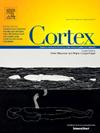The timecourse of inter-object contextual facilitation
IF 3.2
2区 心理学
Q1 BEHAVIORAL SCIENCES
引用次数: 0
Abstract
High-level vision is frequently studied at the level of either individual objects or whole scenes. An intermediate level of visual organisation that has received less attention is the “object constellation” – a familiar configuration of contextually-associated objects (e.g., plate + spoon). Recent behavioural studies have shown that information from multiple objects can be integrated to support observers' high-level understanding of a “scene” and its constituent objects. Here we used EEG in human participants (both sexes) to test when the visual system integrates information across objects to support recognition, using representations of objects' real-world size as a proxy for recognition. We briefly presented masked object constellations consisting of object silhouettes of either large (e.g., chair + table) or small (e.g., plate + spoon) real-world size, while independently varying retinal size. As a control, observers also viewed each silhouette in isolation. If object context facilitates object recognition, real-world size should be inferred more effectively when the objects appear in their contextually-associated pairs than in isolation, leading to the emergence of real-world size information in multivariate EEG patterns. Representational similarity analysis revealed that neural activity patterns captured information about the real-world size of object constellations from ∼200 msec after stimulus onset. This representation was stronger for, and specific to, object pairs as compared to single objects, and remained significant after regressing out visual similarity models derived from computational models. These results provide evidence for inter-object facilitation of visual processing, leading to a qualitatively different high-level representation of object pairs than single objects.
客体间语境促进的时间过程
高级视觉通常在单个物体或整个场景的水平上进行研究。一个被较少关注的中间层次的视觉组织是“物体星座”——一种与上下文相关的物体的熟悉配置(例如,盘子+勺子)。最近的行为研究表明,来自多个对象的信息可以被整合,以支持观察者对“场景”及其组成对象的高层次理解。在这里,我们在人类参与者(男女)中使用脑电图来测试视觉系统何时整合跨物体的信息来支持识别,使用物体真实尺寸的表示作为识别的代理。我们简要地展示了由现实世界大小的物体轮廓组成的蒙面物体星座(例如,椅子+桌子)或小(例如,盘子+勺子),同时独立地改变视网膜大小。作为对照,观察者也单独观察每个剪影。如果物体上下文有助于物体识别,那么当物体以上下文相关的成对出现时,真实世界的大小应该比孤立地出现时更有效地推断出来,从而导致在多变量脑电图模式中出现真实世界的大小信息。表征相似性分析显示,神经活动模式在刺激开始后约200毫秒内捕获了有关真实世界天体星座大小的信息。与单个对象相比,这种表示对于对象对更强,并且特定于对象对,并且在从计算模型中导出的视觉相似性模型回归后仍然显着。这些结果为视觉加工的客体间促进提供了证据,导致客体对的高级表征在质量上不同于单个客体。
本文章由计算机程序翻译,如有差异,请以英文原文为准。
求助全文
约1分钟内获得全文
求助全文
来源期刊

Cortex
医学-行为科学
CiteScore
7.00
自引率
5.60%
发文量
250
审稿时长
74 days
期刊介绍:
CORTEX is an international journal devoted to the study of cognition and of the relationship between the nervous system and mental processes, particularly as these are reflected in the behaviour of patients with acquired brain lesions, normal volunteers, children with typical and atypical development, and in the activation of brain regions and systems as recorded by functional neuroimaging techniques. It was founded in 1964 by Ennio De Renzi.
 求助内容:
求助内容: 应助结果提醒方式:
应助结果提醒方式:


